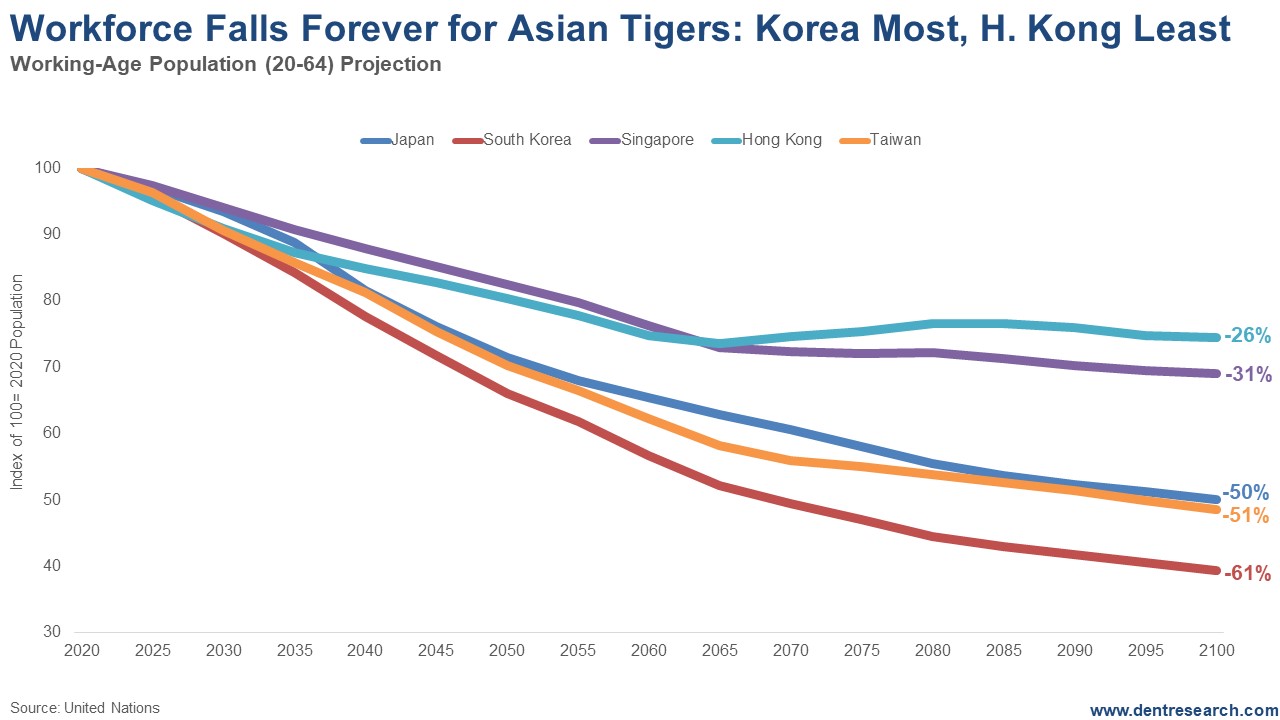I always remind people and economists that Japan was the first Asian Tiger – the first to urbanize rapidly on an S-Curve to $40,000+ GDP per capita PPP and DC (developing country) status in just under 30 years. When I speak in South Korea, I tell them: You are Japan on a 22-year lag for the peaks in your Baby Boom generations and near full urbanization. And they have done the same.
Japan’s Spending Wave peaked in 1996. South Korea peaked recently, in 2018… 22 years later. Taiwan will be the last to peak in a plateau between 2023 and 2026. Basically, the unique and rapid Tiger trend is over.

But now these are the fastest aging DCs in the world, followed closely by many countries in central, southern and eastern Europe.
After flattening for the last two decades, Japan’s workforce is projected to fall 50% by the end of this century, 2100. It will lose 20%, or about 13 out of 68 million, just in the next 20 years, by 2040. Taiwan’s trends are similar.
But the surprise here is South Korea as they were born, urbanized and peaked 22 years later. They will decline by 61% by 2100, and 24% by 2040.
The least aging occurs in Hong Kong and Singapore, as they are both high English-speaking and magnets for professional immigrants. Hong Kong will fall only 26% by 2100, all of that by 2065. Singapore will be 31% with most of that by 2065.
The flip side of such rapid demographic booms and urbanization is that the Baby Boom there went through baby shock. People who move to urban areas and become more affluent have fewer babies. They are much more expensive to raise there, and you want them to go to Harvard! So, you have one or two, and more professionals have none, especially the Millennials there. This happened so fast in these Tiger countries that they had a bigger reaction, and hence faster aging to follow.
There is one country that I call a late blooming Tiger: Malaysia. It has recently broken the DC barrier by reaching $32,000 GDP per capita PPP. It is not as rich as its other Tigers at $40,000+, and it urbanized at a more normal rate on a linear path like most developed countries. It is 77% urban and has 10% or so urbanization potential left and still has positive workforce growth into around 2035-40.
I don’t see any other emerging countries of substance following that S-Curve GDP path from urbanization, not even China. Malaysia is more the model for other Asian emerging countries like India and China that have the potential to become borderline DCs on a straight line GDP/urbanization path – and that’s going to be the biggest thing to happen in Asia as it continues to ascend to dominance on my 165-year East/West Cycle into 2150.
The main point here: All of this important stuff is highly predictable. The next global boom is going to see the West fade faster, especially Europe, East Europe – and Asia lead the ascension of the emerging world even as it’s “star” Tigers fade fast.
